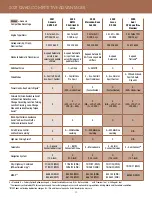
GENESIS RESouRcE LISt
1.
Smart Cruise Control with machine learning (SCC) is not a collision avoidance or warning device. SCC is for highway
use only and should not be used in poor weather, heavy or varying traffic, or on winding or slippery roads. Driver remains
responsible to slow or stop the vehicle to avoid a collision. See Owner’s Manual for details and limitations.
2. The
Blind-Spot View Monitor (BVM) assists the driver in changing lanes by providing a live view of the blind spots on
either side of the vehicle and an audible alert if another vehicle is detected. Turn signal must be activated, and other system
limitations apply. Do not rely exclusively on BVM. It is the driver’s responsibility to be aware of the surroundings and ensure
it is clear before changing lanes or directions. See Owner’s Manual for details and limitations.
3.
Rear Cross-Traffic Collision-Avoidance Assist (RCCA) is designed to notify drivers of approaching cross traffic behind their
vehicle. When another vehicle is detected while you are backing out of a parking spot, it provides audible and visual display
warnings and applies braking if it senses a collision is imminent. RCCA is active when the vehicle is in reverse gear and
backing at a speed less than 6 mph. It only engages during the first activation of reverse gear from park and may not detect
all vehicles, depending on the size, angle, distance and speed of the other vehicle. Never rely exclusively on RCCA. Always
look over your shoulder and use your mirrors to confirm rear clearance. There are limitations to the function, detection,
range and clarity of the system. See Owner’s Manual for details and limitations.
4.
Parking Collision Avoidance Assist (PCCA) helps drivers back out of a parking space by detecting traffic coming from
either side of the vehicle. It can alert the driver of a potential hazard, and, if deemed necessary, can activate braking. PCCA
is active when the vehicle is in reverse gear and operating at low speeds. Never rely exclusively on PCCA when exiting a
parking space, it is not a substitute for attentive driving. Always look over your shoulder and use your mirrors to confirm rear
clearance. There are limitations to the function, detection, range and clarity of the system. PCCA may not function correctly
if one or more of the parking sensors is damaged, dirty or covered or if weather conditions
(heavy rain, snow or fog) are interfering with the sensor operation. See Owner’s Manual for further details and limitations.
5.
Parking Exit Assist (PEA) helps prevent collisions when exiting parallel parking spots. It can alert the driver of a potential
hazard. Never rely exclusively on PEA when exiting a parking space, it is not a substitute for attentive driving. Always look
over your shoulder and use your mirrors to confirm clearance. There are limitations to the function, detection, range and
clarity of the system. PEA may not function correctly if one or more of the parking sensors is damaged, dirty or covered or
if weather conditions (heavy rain, snow or fog) are interfering with the sensor operation. See Owner’s Manual for further
details and limitations.
6. When your vehicle is parked,
Safe Exit Assist (SEA) can alert occupants planning to exit when a vehicle is approaching from
behind. When Child Locks are active, SEA helps prevent the rear doors from opening if a vehicle approaching from behind is
detected. SEA is not a substitute for attentive driving. See Owner’s Manual for details and limitations.
7.
Highway Driving Assist II (HDA) is for highway use only and helps keep your vehicle centered in its lane while maintaining
a safe distance from the vehicle ahead. Lane markings must be clearly visible on the road. HDA should not be used in poor
weather, heavy or varying traffic, or on winding or slippery roads. HDA will not work under all circumstances and will not
prevent loss of control. Driver remains responsible to slow or stop the vehicle to avoid a collision. See Owner’s Manual for
details and limitations.
8.
Forward Collision-Avoidance Assist (FCA) w/ Pedestrian & Cyclist Detection helps detect pedestrians and cyclists, but not
in all conditions. FCA is designed to assist drivers to avoid, or reduce the severity of, collisions with cars that have slowed or
stopped in front of them. The system is not designed to detect certain stationary objects such as trees or poles, and may not
detect all vehicles, pedestrians and cyclists under certain road, weather and vehicle conditions. It is a supplemental assist
and does not replace the need for extreme care and attention by the driver. FCA may not stop the vehicle completely and
will not avoid all collisions. The driver is responsible for being attentive and maintaining control of the vehicle and should
not wait for the system’s alerts before braking as there may not be sufficient time to brake safely. See Owner’s Manual for
further details and limitations.
These are conditions referenced in the Owner’s Manual where the system may not detect a pedestrian or cyclist:
· The pedestrian or cyclist is not fully captured by the camera sensor, or the pedestrian does not walk in the
upright position
· The pedestrian or cyclist moves very fast
· The pedestrian or cyclist abruptly appears in front
· The pedestrian or cyclist wears clothes in the color similar to the background
· The outside is too bright or too dark
FEATURE-by-FEATURE DISCLAImERS
27




































